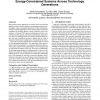Free Online Productivity Tools
i2Speak
i2Symbol
i2OCR
iTex2Img
iWeb2Print
iWeb2Shot
i2Type
iPdf2Split
iPdf2Merge
i2Bopomofo
i2Arabic
i2Style
i2Image
i2PDF
iLatex2Rtf
Sci2ools
116
click to vote
CASES
2006
ACM
2006
ACM
Architecture and circuit techniques for low-throughput, energy-constrained systems across technology generations
Rising interest in the applications of wireless sensor networks has spurred research in the development of computing systems for lowthroughput, energy-constrained applications. Unlike traditional performance oriented applications, sensor network nodes are primarily constrained by operation lifetime, which is limited by power consumption. Advanced CMOS process technologies provide ever increasing transistor density and improved performance characteristics. However, shrinking feature size and decreasing threshold voltages also lead to significant increases in leakage current, which is especially troublesome for applications with significant idle times. This work investigates tradeoffs between leakage and active power for low-throughput applications. We study these issues across a range of process technologies on a computing architecture that provides explicit support for fine-grain leakage-control techniques such as Vdd-gating and adaptive body bias. We present a methodology for sele...
Related Content
| Added | 13 Jun 2010 |
| Updated | 13 Jun 2010 |
| Type | Conference |
| Year | 2006 |
| Where | CASES |
| Authors | Mark Hempstead, Gu-Yeon Wei, David Brooks |
Comments (0)

